
Lace is a delicate fabric made of yarn or thread in an open weblike pattern, made by machine or by hand. Generally, lace is divided into two main categories, needlelace and bobbin lace, although there are other types of lace, such as knitted or crocheted lace. Other laces such as these are considered as a category of their specific craft. Knitted lace, therefore, is an example of knitting. This article considers both needle lace and bobbin lace.

Bobbin lace is a lace textile made by braiding and twisting lengths of thread, which are wound on bobbins to manage them. As the work progresses, the weaving is held in place with pins set in a lace pillow, the placement of the pins usually determined by a pattern or pricking pinned on the pillow.
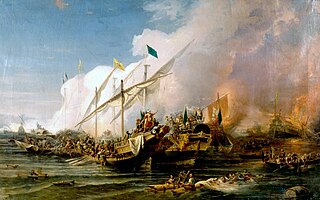
The Battle of Preveza was a naval battle that took place on 28 September 1538 near Preveza in Ionian Sea in northwestern Greece between an Ottoman fleet and that of a Holy League assembled by Pope Paul III. It occurred in the same area in the Ionian Sea as the Battle of Actium, 31 BC. It was one of the three largest sea battles that took place in the sixteenth century Mediterranean, along with the Battle of Djerba and the Battle of Lepanto. In this battle, the Ottomans defeated the Europeans.

A bobbin or spool is a spindle or cylinder, with or without flanges, on which yarn, thread, wire, tape or film is wound. Bobbins are typically found in industrial textile machinery, as well as in sewing machines, fishing reels, tape measures, film rolls, cassette tapes, within electronic and electrical equipment, and for various other applications.
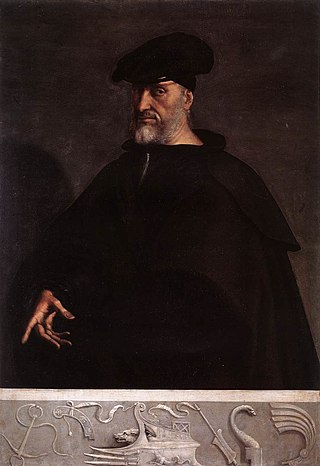
Andrea Doria, Prince of Melfi was a Genoese statesman, condottiero, and admiral, who played a key role in the Republic of Genoa during his lifetime.

The Republic of Genoa was a medieval and early modern maritime republic from the 11th century to 1797 in Liguria on the northwestern Italian coast. During the Late Middle Ages, it was a major commercial power in both the Mediterranean Sea and the Black Sea. Between the 16th and 17th centuries it was one of the major financial centers in Europe.
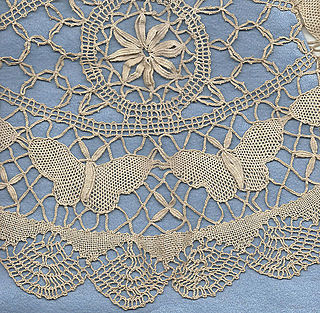
Guipure lace is a type of bobbin lace. It connects the motifs with bars or plaits rather than net or mesh.
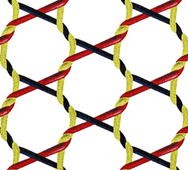
Bobbinet tulle or genuine tulle is a specific type of tulle which has been made in the United Kingdom since the invention of the bobbinet machine. John Heathcoat coined the term "bobbin net", or bobbinet as it is spelled today, to distinguish this machine-made tulle from the handmade "pillow lace", produced using a lace pillow to create bobbin lace. Machines based on his original designs are still in operation today producing fabrics in Perry Street, Chard, Somerset, UK.

Genoa, Italy, has historically been one of the most important ports on the Mediterranean.
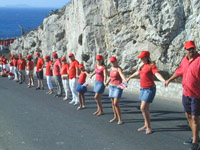
Gibraltarians is a term used to refer to the inhabitants of Gibraltar, a British overseas territory located near the southernmost tip of the Iberian Peninsula at the entrance to the Mediterranean Sea.
Guglielmo Grasso, sometimes anglicized William Grassus, was a Genoese merchant, pirate and admiral.
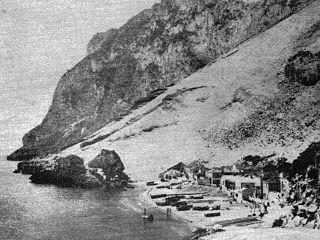
A Genoese community has existed in Gibraltar since the 16th century and later became an important part of the population.
Argentella is a type of needle lace derived from Argentan lace, with a Rosacé ground, a "striking ground of tiny webs."
Argentella: A French needle lace made also at Abbisola in Italy. Developed from Argentan with Rosacé ground.
Argentella. A name given to a lace made in Genoa [Italy], but worked much like [the French] Point d'Alençon.
argentella lace[:] An early, white needlepoint lace made in Italy. Similar to the Alençon lace, but made with flat cordonnet. The patterns are delicate and spread over a net ground with small dots at the corners.
Argentella. ...a variant of point d'Alençon, which has a large mesh with a six-sided dot in the centre. This dotted réseau is known as fond de neige, and œil de perdrix, also as réseau rosaceé.
Yak lace refers to a coarse bobbin lace in the guipure manner, typically made from wool. It was mainly made in Oxfordshire, Buckinghamshire and Northamptonshire in imitation of Maltese and Greek laces. While the name suggests the lace is made using yak hair, it can be made of any wool or worsted yarn.

Bedfordshire lace is a style of bobbin lace originating from Bedfordshire in the 19th century, and made in the English Midlands lacemaking area. It was worked as a continuous width on a bolster pillow. It is a guipure style of lace.

Maltese lace is a style of bobbin lace made in Malta. It is a guipure style of lace. It is worked as a continuous width on a tall, thin, upright lace pillow. Bigger pieces are made of two or more parts sewn together.

Genoa is the capital of the Italian region of Liguria and the sixth-largest city in Italy. In 2015, 594,733 people lived within the city's administrative limits. As of the 2011 Italian census, the Province of Genoa, which in 2015 became the Metropolitan City of Genoa, had 855,834 resident persons. Over 1.5 million people live in the wider metropolitan area stretching along the Italian Riviera.

The Battle of Saseno took place on 14 August 1264 near Saseno island off the coast of Albania, between a fleet of the Republic of Genoa and a trade convoy of the Republic of Venice, during the War of Saint Sabas. So far in the war, the Genoese had experienced only defeats in direct confrontations with the Venetian navy, and had therefore resorted to raiding the Venetian commerce convoys to the Levant, which were critical to the Venetian economy.

Portrait of a Lady Holding a Fan is a painting by the Italian artist Artemisia Gentileschi. Executed in the mid-1620s, it is part of the collection of The Sovereign Military Order of Malta. There is no firm idea who the sitter is, although some historians have wondered if the portrait is indeed a self-portrait. However, given the rich clothing and jewellery of the sitter, this is unlikely.

Bendinelli Negrone was the 133rd Doge of the Republic of Genoa and King of Corsica, Cyprus and Jerusalem.



















